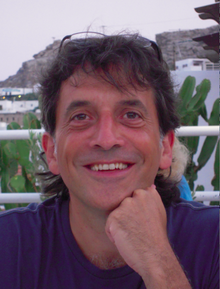Andrea Musacchio
Andrea Musacchio | |
|---|---|
 | |
| Born | Andrea Musacchio July 11, 1964 |
| Nationality | Italian |
| Alma mater | University of Rome Tor Vergata,European Molecular Biology Laboratory |
| Scientific career | |
| Fields | Crystallography |
| Institutions | Harvard Medical School,European Institute of Oncology,Max Planck Institute for Molecular Physiology |
| Doctoral advisor | Matti Saraste |
| Other academic advisors | Gianni Cesareni |
Andrea Musacchio(born July 11, 1964)[1]is an Italian structural biologist. He is Max Planck director at theInstitute of Molecular Physiologyin Dortmund. He is also Honorary Professor at theCenter for Medical Biotechnologyat theUniversity of Duisburg-Essen.He was namedEuropean Molecular Biology Organizationmember in 2009.[2]
Education and career
[edit]Musacchio received aLaureainBiologyfrom theUniversity of Rome Tor Vergatasummacum laudein 1990, and earned hisPh.D.,summacum laude,from theHeidelberg Universityin 1995 working at theEuropean Molecular Biology Laboratory.For hispostdoctoralstudies he joinedStephen C. Harrisonlaboratory at theHarvard Medical SchoolinBoston.In 1999 he returned to Italy to found his laboratory at theEuropean Institute of OncologyinMilan,where he started working on mechanisms ofcell division.He was aEuropean Molecular Biology OrganizationYoung Investigator from 2000-2004. Musacchio moved to Dortmund in 2011 to direct the Department of Mechanistic Cell Biology at theMax Planck Institute for Molecular Physiology[3]
Research
[edit]Musacchio approached structural biology during hisPh.D.,contributing to the determination of the first crystallographic structures of theSH3[4]andPH[5]domains. During his post-doctoral training, he was involved in the determination of theclathrintriskelion structure,[6]one of the first studies combiningX-ray crystallographyandelectron microscopy. As an independent scientist, his interests focused on the understanding of the molecular basis ofmitosis,with emphasis on thespindle assembly checkpoint.Since the early days, Musacchio's lab adopted a multi-disciplinary approach merging structural biology, biochemistry and cellular biology, this way gaining comprehensive views on protein functions in living cells.[7]He is best known for his work on Mad1/Mad2 complexes,[8][9]which led to the formulation of thetemplate model,[10]and for his contributions to the understanding of the role of the kinaseAurora B,Mps1 and Haspin inmitosis.[11][12][13][14]In 2008, the structure of the Ndc80 complex[15]set the foundation of a new line of his investigations onkinetochoreassembly and attachment tomicrotubules[16][17][18]
Personal life
[edit]Musacchio spent his childhood in Rome, where he grew to be a strong supporter ofA.S. Roma.He has started embracingBorussia Dortmund.
He is married and father of two boys.
References
[edit]- ^"Musacchio, Andrea".mpg.de.Retrieved2024-01-12.
- ^2009 EMBO Press ReleaseArchived2014-12-09 at theWayback Machine
- ^Musacchio A. (2012)."Andrea Musacchio".Current Biology.22(14): R552–R554.doi:10.1016/j.cub.2012.06.024.PMID23012739.
- ^Musacchio, A; Noble, M; Pauptit, R; Wierenga, R; Saraste, M (Oct 29, 1992). "Crystal structure of a Src-homology 3 (SH3) domain".Nature.359(6398): 851–5.Bibcode:1992Natur.359..851M.doi:10.1038/359851a0.PMID1279434.S2CID4254768.
- ^Macias, MJ; Musacchio, A; Ponstingl, H; Nilges, M; Saraste, M; Oschkinat, H (Jun 23, 1994). "Structure of the pleckstrin homology domain from beta-spectrin".Nature.369(6482): 675–7.Bibcode:1994Natur.369..675M.doi:10.1038/369675a0.PMID8208297.S2CID4358947.
- ^Musacchio, A; Smith, CJ; Roseman, AM; Harrison, SC; Kirchhausen, T; Pearse, BM (Jun 1999)."Functional Organization of Clathrin in Coats: Combining Electron Cryomicroscopy and X-Ray Crystallography".Molecular Cell.3(6): 761–70.doi:10.1016/S1097-2765(01)80008-3.PMID10394364.
- ^Nasmyth, K (Mar 25, 2005)."How do so few control so many?".Cell.120(6): 739–46.doi:10.1016/j.cell.2005.03.006.PMID15797376.S2CID18831437.
- ^Sironi, L; Mapelli, M; Knapp, S; De Antoni, A; Jeang, KT; Musacchio, A (May 15, 2002)."Crystal structure of the tetrameric Mad1-Mad2 core complex: implications of a 'safety belt' binding mechanism for the spindle checkpoint".The EMBO Journal.21(10): 2496–506.doi:10.1093/emboj/21.10.2496.PMC126000.PMID12006501.
- ^Mapelli, M; Massimiliano, L; Santaguida, S; Musacchio, A (Nov 16, 2007)."The Mad2 conformational dimer: structure and implications for the spindle assembly checkpoint"(PDF).Cell.131(4): 730–43.doi:10.1016/j.cell.2007.08.049.hdl:2434/65744.PMID18022367.S2CID17345925.
- ^De Antoni, A; Pearson, CG; Cimini, D; Canman, JC; Sala, V; Nezi, L; Mapelli, M; Sironi, L; Faretta, M; Salmon, ED; Musacchio, A (Feb 8, 2005)."The Mad1/Mad2 complex as a template for Mad2 activation in the spindle assembly checkpoint".Current Biology.15(3): 214–25.doi:10.1016/j.cub.2005.01.038.PMID15694304.S2CID3224122.
- ^De Antoni, A; Maffini, S; Knapp, S; Musacchio, A; Santaguida, S (Oct 15, 2012)."A small-molecule inhibitor of Haspin alters the kinetochore functions of Aurora B."(PDF).The Journal of Cell Biology.199(2): 269–84.doi:10.1083/jcb.201205119.PMC3471222.PMID23071153.
- ^Santaguida, S; Vernieri, C; Villa, F; Ciliberto, A; Musacchio, A (Apr 20, 2011)."Evidence that Aurora B is implicated in spindle checkpoint signalling independently of error correction".The EMBO Journal.30(8): 1508–19.doi:10.1038/emboj.2011.70.PMC3102279.PMID21407176.
- ^Santaguida, S; Tighe, A; D'Alise, AM; Taylor, SS; Musacchio, A (Jul 12, 2010)."Dissecting the role of MPS1 in chromosome biorientation and the spindle checkpoint through the small molecule inhibitor reversine".The Journal of Cell Biology.190(1): 73–87.doi:10.1083/jcb.201001036.PMC2911657.PMID20624901.
- ^Sessa, F; Mapelli, M; Ciferri, C; Tarricone, C; Areces, LB; Schneider, TR; Stukenberg, PT; Musacchio, A (Apr 29, 2005)."Mechanism of Aurora B activation by INCENP and inhibition by hesperadin".Molecular Cell.18(3): 379–91.doi:10.1016/j.molcel.2005.03.031.PMID15866179.
- ^Ciferri, C; Pasqualato, S; Screpanti, E; Varetti, G; Santaguida, S; Dos Reis, G; Maiolica, A; Polka, J; De Luca, JG; De Wulf, P; Salek, M;Rappsilber, J;Moores, CA; Salmon, ED; Musacchio, A (May 2, 2008)."Implications for kinetochore-microtubule attachment from the structure of an engineered Ndc80 complex".Cell.133(3): 427–39.doi:10.1016/j.cell.2008.03.020.PMC4754795.PMID18455984.
- ^Santaguida, S; Musacchio, A (Sep 2, 2009)."The life and miracles of kinetochores".The EMBO Journal.28(17): 2511–31.doi:10.1038/emboj.2009.173.PMC2722247.PMID19629042.
- ^Petrovic, A; Mosalaganti, S; Keller, J; Mattiuzzo, M; Overlack, K; Krenn, V; De Antoni, A; Wohlgemuth, S; Cecatiello, V; Pasqualato, S; Raunser, S; Musacchio, A (Feb 20, 2014)."Modular assembly of RWD domains on the Mis12 complex underlies outer kinetochore organization".Molecular Cell.53(4): 591–605.doi:10.1016/j.molcel.2014.01.019.hdl:10281/397721.PMID24530301.
- ^Basilico, F; Maffini, S; Weir, JR; Prumbaum, D; Rojas, AM; Zimniak, T; De Antoni, A; Jeganethan, S; Voss, B; van Gerwen, S; Krenn, V; Massimiliano, L; Valencia, A; Vetter, IR; Herzog, F; Raunser, S; Pasqualato, S; Musacchio, A (Jul 8, 2014)."The pseudo GTPase CENP-M drives human kinetochore assembly".eLife.3:e02978.doi:10.7554/elife.02978.PMC4080450.PMID25006165.
